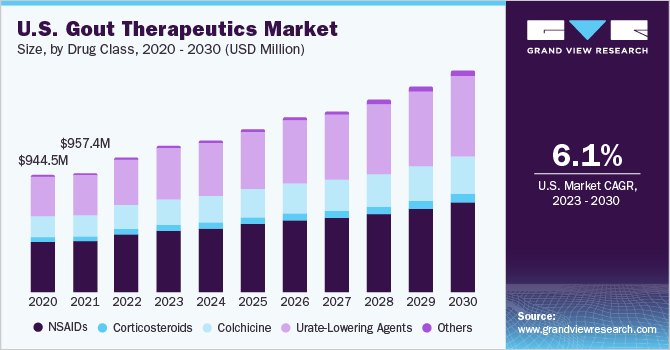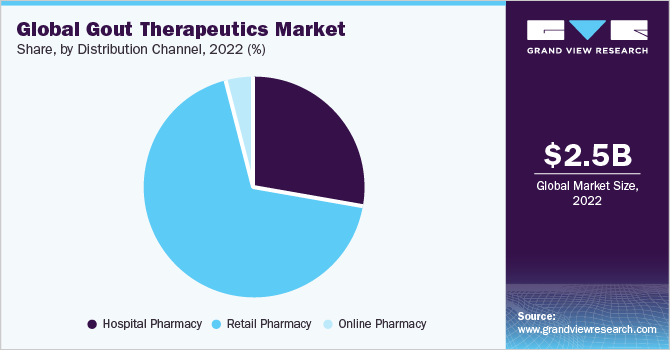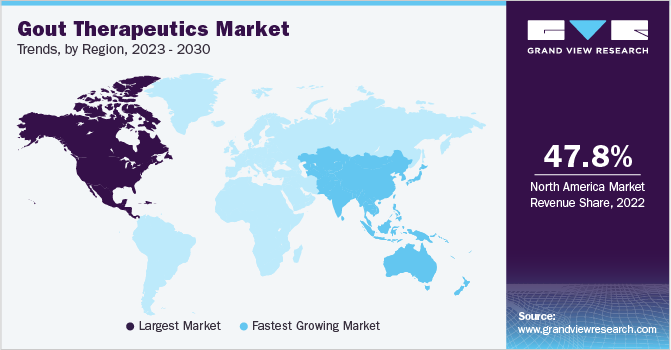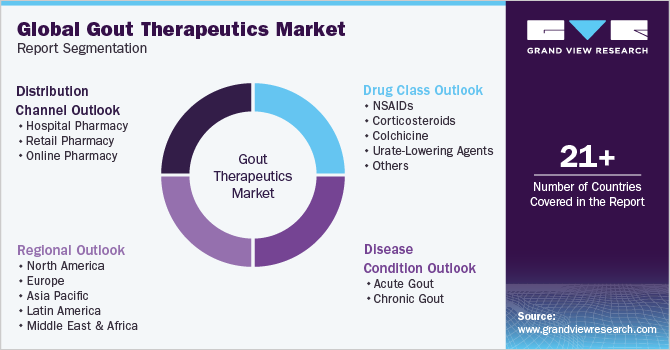- Home
- »
- Pharmaceuticals
- »
-
Gout Therapeutics Market Size, Share & Trends Report 2030GVR Report cover
![Gout Therapeutics Market Size, Share & Trends Report]()
Gout Therapeutics Market Size, Share & Trends Analysis Report By Drug Class (NSAIDs, Corticosteroids, Colchicine), By Disease Condition (Acute, Chronic), By Distribution Channel, By Region, And Segment Forecasts, 2023 - 2030
- Report ID: GVR-1-68038-717-9
- Number of Report Pages: 100
- Format: PDF, Horizon Databook
- Historical Range: 2018 - 2021
- Forecast Period: 2023 - 2030
- Industry: Healthcare
Gout Therapeutics Market Size & Trends
The global gout therapeutics market size was valued at USD 2.49 billion in 2022 and is expected to grow at a compound annual growth rate (CAGR) of 6.25% from 2023 to 2030. This growth is primarily attributed to the increasing prevalence of gout and rising awareness among people about the disease treatment. Furthermore, the space has advanced and new therapeutic options with a robust drug pipeline are further accelerating the space growth. However, delayed gout diagnosis among patients in developing and underdeveloped nations has slowed the market growth. According to the Annals of Rheumatic Diseases article, in 2021, the prevalence of gout was about 2.33% in the United Kingdom.

Moreover, Canadian Medical Association reported around a 4% prevalence rate. Therefore, high disease prevalence is fueling the demand for gout therapeutics. Gout rarely exists in isolation. Several co-morbidities associated with it include renal diseases, hypertension, diabetes, obesity, and other health conditions that aggravate the symptoms and further drive market growth. For instance, research has shown that there is a link between gout and diabetes, with 26% of Gout patients also suffering from diabetes.
The strong research and development in the space have led to a robust product pipeline. For instance, in March 2023, Selecta Biosciences, Inc announced positive results for the Phase 3 DISSOLVE I & II placebo-controlled randomized clinical trials of SEL-212. SEL-212 is indicated for chronic refractory gout. Similarly, in September 2022, Jiangsu HengRui Medicine Co., Ltd.’s SHR4640 was in a phase 3 trial to lower serum uric acid levels in patients. In addition, LG Chem’s LC350189, Shanton Pharma’s SAP-001, and InventisBio’s D-0120 are novel drugs under phase 2 trials, creating fierce competition among players to bring the product to the market. Subsequent approval and launch of these products in coming years are expected to offer a lucrative opportunity for growth in the market.
Government agencies and private organizations strive to raise awareness through various awareness campaigns, further driving space growth. For instance, in March 2020, Down and Out Kidney, a campaign launched by Horizon Therapeutics plc, focused on the impact of the accumulation of uric acid and gout in patients suffering from chronic kidney disease. Moreover, every year, 22nd May is dedicated as National Gout Awareness Day in the U.S. On this day, associations such as the Gout Education Society actively engaged in the gout awareness campaign to raise public awareness about gout. Such initiatives are increasing the demand for treatment and fueling market growth.
Drug Class Insights
The NSAIDs drug class segment dominated the gout therapeutics market with a revenue share of 43.13% in 2022. This can be attributed to factors such as the high market penetration of NSAIDs drugs in the space, used as the first line of treatment, with benefits such as lower costs, and high usage in combination therapy. Indomethacin, celecoxib, and naproxen are the major drugs used for the management of acute attacks of the disease. High doses of short-acting drugs provide better relief from symptoms. Additionally, practitioners prefer combination therapy in cases of chronic gout. For instance, a combination of febuxostat, colchicine, or allopurinol is prescribed in combination with NSAIDs.
Urate-lowering agent, a more recently developed segment, is expected to grow at a significant CAGR over the forecast period. This can be attributed to the growing adoption of xanthine oxidase inhibitors such as febuxostat and uricosuric agents. Furthermore, novel drugs in the space further boost the market growth. For instance, in contrast to conventional gout drugs targeting either hyperuricemia or inflammation, novel drugs such as arhalofenate have anti-inflammatory and urate-lowering properties that increase their efficacy and therapeutic value, thereby expected to increase their adoption and prescription rate.
Disease Condition Insights
The acute condition segment held a revenue share of 65.77% in 2022. It is mainly due to the high patient pool compared to chronic conditions. This segment is expected to maintain its dominance during the forecast period. Acute gout treatment majorly involves NSAIDs, colchicine, and corticosteroids. Although the drugs have significant penetration in the market, patients’ non–adherence to treatment remains the major constraint to growth.
Fast-acting NSAIDs are the first choice for the treatment of acute gout when there are no contraindications. Patients with renal insufficiency, peptic ulcer, congestive heart failure, and risk of gastrointestinal bleeding limit the use of NSAIDs among patients. According to KOLs, rheumatologists preferred corticosteroids over NSAIDs for acute gout. Corticosteroids are helpful in patients who cannot tolerate NSAIDs. Colchicines have been used for an extended period for the treatment of acute conditions; however, their preference for them has been reduced due to poor tolerability and narrow therapeutic index.
Distribution Channel Insights
The retail pharmacy segment held the highest market share of 67.56% in 2022. Ease of availability in the in-house setting is among the primary factor fueling the segment growth. Retail chains are available 24/7 for service to customers. Moreover, the availability of investment in automating retail pharmacies to process pharmacy insurance information has contributed to the development of the retail supply chain. The technicians use medical billing and coding to modify medical information into billable codes leading to sustainable systems and driving segment growth.

However, the online pharmacy distribution channel is anticipated to grow at the fastest rate over the forecast period. The growth of the segment is driven by attractive offerings such as discounts & gifts on purchases, price transparency, and increasing home delivery services. In addition, when information technology penetrates the healthcare sector, prescribers will be able to submit prescriptions electronically and offer a lucrative opportunity for the segment’s growth.
Regional Insights
North America dominated the overall gout therapeutics market in terms of revenue with a share of 47.81% in 2022, owing to the presence of key players, the rising prevalence of the disease, and high disease awareness that further led to high diagnostic and treatment rates in the U.S. Furthermore, the better healthcare access and expected new drugs launch in the region will further strengthen its market presence in coming years.

The North America market is dominated by the U.S., followed by Canada. Various organizations such as Gout & Uric Acid Education Society (GUAES) work toward raising awareness about gout. GUAES conducts awareness campaigns on National Gout Awareness Day. Similarly, the professional football legend Emmitt Smith partnered with Takeda Pharmaceuticals, U.S.A., for the “Champion for Gout Awareness” campaign to spread awareness about gouty arthritis. Thus, increasing awareness encourages patients to seek a diagnosis for gout, thus contributing to market growth.
Moreover, Asia Pacific is expected to be the fastest-growing region due to the rising prevalence of patients. Rising investments from major players in the region are expected to offer a lucrative opportunity for segment growth over the coming years.
Key Companies & Market Share Insights
A leading number of these players are rapidly opting for geographical expansion, drug-label expansion, strategic collaborations, and partnerships through mergers and acquisitions in emerging and economically favorable regions. For instance, in March 2023, Protalix BioTherapeutics, Inc. announced the initiation of phase 1 of the First in Human (FIH) clinical trial of PRX-115. It is a recombinant PEGylated uricase under development and investigated for the treatment of severe gout. The clinical trial is being conducted under the Medical Devices Safety Authority (MedSafe), Health and Disability Ethics Committee (HDEC), and also as per the New Zealand Medicines guidelines under the New Zealand Clinical Research Authority. The trial is expected to enroll around 56 patients who have no history of exposure to PEGylated uricase. Some prominent players in the global gout therapeutics market include:
-
Takeda Pharmaceutical Company Ltd.
-
Novartis AG
-
Regeneron Pharmaceuticals Inc.
-
AstraZeneca plc
-
Horizon Therapeutics plc
-
Merck & Co. Inc.
-
Teijin Pharma Ltd.
-
GlaxoSmithKline, Plc.
-
Zydus Group
Gout Therapeutics Market Report Scope
Report Attribute
Details
Market size value in 2023
USD 2.70 billion
Revenue forecast in 2030
USD 4.13 billion
Growth rate
CAGR of 6.25% from 2023 to 2030
Base year for estimation
2022
Historical data
2018 - 2021
Forecast period
2023 - 2030
Report updated
June 2023
Quantitative units
Revenue in USD million/billion, CAGR from 2023 to 2030
Report coverage
Revenue Forecast, company ranking, competitive landscape, growth factors, trends
Segments covered
Drug class, disease condition, distribution channel, region
Regional scope
North America; Europe; Asia Pacific; Latin America; Middle East & Africa
Country scope
U.S.; Canada; U.K.; Germany; France; Spain; Italy; Denmark; Sweden, Norway; Japan; China; India; Australia; South Korea; Thailand Brazil; Mexico; Argentina; South Africa; Saudi Arabia; UAE; Kuwait
Key companies profiled
GlaxoSmithKline plc; Takeda Pharmaceutical Company Ltd.; Regeneron Pharmaceuticals Inc; Novartis AG; AstraZeneca plc; Merck & Co. Inc.; Teijin Ltd.; Horizon Therapeutics plc; Zydus Group.
Customization scope
Free report customization (equivalent to up to 8 analysts' working days) with purchase. Addition or alteration to country, regional & segment scope.
Pricing and purchase options
Avail customized purchase options to meet your exact research needs. Explore purchase options
Global Gout Therapeutics Market Report Segmentation
This report forecasts revenue growth at global, regional, and country levels and provides an analysis of the latest industry trends in each of the sub-segments from 2018 to 2030. For the purpose of this study, Grand View Research has segmented the global gout therapeutics industry report based on drug class, disease condition, distribution channel, and region:

-
Drug Class Outlook (Revenue, USD Million, 2018 - 2030)
-
NSAIDs
-
Corticosteroids
-
Colchicine
-
Urate-Lowering Agents
-
Others
-
-
Disease Condition Outlook (Revenue, USD Million, 2018 - 2030)
-
Acute Gout
-
Chronic Gout
-
-
Distribution Channel Outlook (Revenue, USD Million, 2018 - 2030)
-
Hospital Pharmacy
-
Retail Pharmacy
-
Online Pharmacy
-
-
Regional Outlook (Revenue, USD Million, 2018 - 2030)
-
North America
-
U.S.
-
Canada
-
Europe
-
Germany
-
UK
-
France
-
Italy
-
Spain
-
Denmark
-
Sweden
-
Norway
-
Asia Pacific
-
China
-
India
-
Japan
-
Australia
-
South Korea
-
Thailand
-
Latin America
-
Brazil
-
Mexico
-
Argentina
-
Middle East & Africa
-
South Africa
-
Saudi Arabia
-
UAE
-
Kuwait
-
Frequently Asked Questions About This Report
b. The global gout therapeutics market size was estimated at USD 2.49 billion in 2022 and is expected to reach USD 2.70 billion in 2023.
b. The global gout therapeutics market is expected to grow at a compound annual growth rate of 6.25% from 2023 to 2030 to reach USD 4.13 billion by 2030.
b. North America dominated the market for gout therapeutics market with a share of 47.81% in 2022. This is attributable to the presence of key players, rising prevalence of disease, and high disease awareness that further led to high diagnostic and treatment rates in the U.S.
b. Some key players in the space include GlaxoSmithKline plc; Takeda Pharmaceutical Company Ltd.; Regeneron Pharmaceuticals Inc; Novartis AG; AstraZeneca plc; Merck & Co. Inc.; Teijin Ltd.; and Horizon Pharma plc; Zydus Group and others.
b. Key factors that are driving the gout therapeutics market growth include a robust late-stage product pipeline and rising disease prevalence
Share this report with your colleague or friend.
![gvr icn]()
NEED A CUSTOM REPORT?
We can customize every report - free of charge - including purchasing stand-alone sections or country-level reports, as well as offer affordable discounts for start-ups & universities. Contact us now
![Certified Icon]()
We are GDPR and CCPA compliant! Your transaction & personal information is safe and secure. For more details, please read our privacy policy.
We are committed towards customer satisfaction, and quality service.
"The quality of research they have done for us has been excellent."





